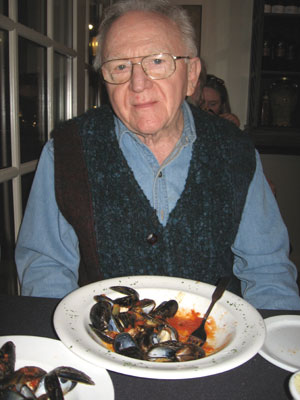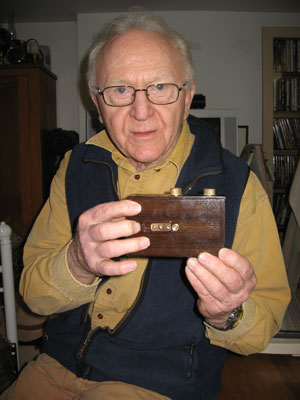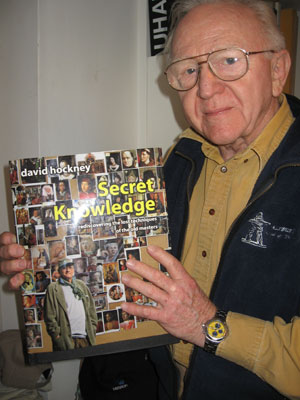| January
27, 2007
Presenting: John Dowding – A Private
Lesson in Photography from a True Master
John Dowding
and I first met a few days ago at Spiaggia
Trattoria where I was doing an interview with the owner, Mary
Lee. Right in the restaurant she connected me with John who was
quietly enjoying a plate of mussels. I sat down with John for about
twenty minutes, and as we talked I realized we had a lot in common:
a passion for visual arts, photography and travel. John invited
me to call him to arrange a visit at his studio another day so he
would be able to show me his work.

John Dowding
John Dowding has more than 50 years of arts teaching experience.
After taking a degree in fine arts and history at McMaster University
in Hamilton, John taught at various high schools in southern Ontario
and was the head of the art department at Lorne Park Secondary School
in Mississauga from 1969 to 1986, the high school that famous Canadian
Olympians Silken Laumann and John Wood graduated from. From 1993
to 1995 he completed a degree in Photographic Arts at Ryerson University,
the first year Ryerson had received its official designation as
a university.
Photography has been John Dowding’s passion for many years
now. During the last five years he has started to discover Cuba,
and spent several weeks every winter in this fascinating country.
In just a few days (February 2) John will be leaving for Cuba again:
to run the “Cuba Now and Then” Photography
Workshop and Tour. This ten-day tour will take participants to Havana
where they will spend three days taking photos of various historic
parts of the city including the Cementario Colon where the students
will be practicing infrared photography.
 From there
the group will move on to the French colonial city of Cienfuegos,
then to historic Trinidad de Cuba where they will spend two-and-a-half
days. Before returning to Havana, the group will also spend two
days in Santiago de Cuba, the second largest city on the island
and a former capital of the country. Opportunities will exist to
photograph architecture, landscapes and special events such as flamenco
and dance shows. From there
the group will move on to the French colonial city of Cienfuegos,
then to historic Trinidad de Cuba where they will spend two-and-a-half
days. Before returning to Havana, the group will also spend two
days in Santiago de Cuba, the second largest city on the island
and a former capital of the country. Opportunities will exist to
photograph architecture, landscapes and special events such as flamenco
and dance shows.
Havana discovered
John usually focusses on architectural photography, and also uses
special equipment such as infrared film and pinhole cameras to achieve
special effects which he teaches to his workshop participants. One
of his favourite photos of Havana was of a group of school-age boys
who were swimming in the ocean just off Havana’s Malecon.
When they came out of the water they were still looking at each
other, an image that reminded John of a frieze in a Greek drama.
Over the last few years, John
Dowding has formed an intense connection to Cuba, and he said
he wanted to “get there before the Americans”. When
he arrived in Havana for the first time, he couldn’t believe
his eyes, the fascination and attraction were instant. John and
I discussed Havana, a city we both know well. To explore the city,
John hired a team of local carriage drivers, who were actually a
doctor and a nurse. I had spent some time in Havana myself a couple
of years ago, to study Spanish at the University
of Havana. Just like John, I learned very quickly that the tourism
trade is much more lucrative for the locals than practicing their
professions. Working as a waiter, tour guide or taxi driver allows
Cubans to make in one day a multiple of their usual monthly wages
of about $8 to $25 (per month!).
So this team of medical professionals driving a horse carriage
for tourists became his tour guides and introduced him to one of
the most captivating cities in the New World. The fascination has
never left and John has been to Havana, which he calls “a
city in a time warp”, several times over the last few years.
He will run another photo tour to Cuba from April 6 to 15. Through
the same company (Cuba Si Tours) John will take another group of
photo enthusiasts to Tuscany later this year, an area to which John
refers as one of the cradles of Western civilization, certainly
as far as art history is concerned.
Havana discovered
After this inspiring conversation I left John to finish his mussels
and resolved to see him a few days later at his private studio in
order to catch him before his departure for Cuba. So today after
my interview with Steve and Paul, the owners of Accommodate
The Soul B&B, I headed over to John Dowding’s residence
on a quiet historic side street in the Beach.
John’s studio is currently undergoing reconstruction, so
some of his images were packed away. But I was able to view several
samples of his unique artwork, including some examples of his “PreCambrian”
photo series. John explained that he spent some time in a friend’s
cottage on Georgian Bay, and as he was feeding the fish he discovered
beautifully coloured striated rocks that make up the Canadian shield.
Also referred to as the Pre-Cambrian Shield, this ancient
geological formation is the earth’s largest area of exposed
'shield' rock. The rock formations date back to the Precambrian
Era, between 3.5 to 4 billion years ago, long before living creatures
ever appeared on this planet. The ancient rocks contain beautifully
coloured, striped and twisted formations.
The "Pre-Cambrian" series
Another series of pictures relates to John’s explorations
of Cuba. In addition to standard digital and conventional photography,
John uses
infrared film, particularly in environments that already have a
somewhat surreal ambience to them, for example cemeteries. In addition,
John uses a unique piece of photographic equipment: a pinhole camera.
He showed me two samples of this type of equipment – pinhole
cameras essentially consist of a simple wooden box with no lens.
The shutter is essentially a hole in the box that needs to be exposed
manually by opening and closing a cover above the hole. Inside the
box is a roll of 120 film. John explained that one of his pinhole
cameras was made in Hong Kong of mahogany and brass. He took one
with him on his first trip to Havana in 2002, and it has become
his favourite piece of equipment ever since.

John demonstrates the pinhole camera
John explained that exposure has to be calculated manually using
certain formulas. Double exposures are easily created, which results
in surreal and often bizarre special effects. Early versions of
pinhole cameras were described by Aristotle in 300 B.C. Pinhole
cameras share certain characteristics with the “camera lucida”,
an optical device that was reportedly used by artists such as Vermeer
and Frans Hals to accurately depict reality. According to John,
these painters were able to capture fleeting expressions such as
smiles and laughter, a visual feat that only became feasible as
a result of using the camera lucida.
Pinhole images of Havana
The camera lucida optically superimposes the object being viewed
onto the drawing surface, even allowing the artist to trace the
outlines of the objects to be painted. As a result, these painters
never used sketches for their paintings, they painted directly on
a canvas - "a la prima", aided by the help of the camera
lucida that would project the image onto their canvas.
John also showed me a book entitled “Secret Knowledge –
Rediscovering the Lost Techniques of the Old Masters”, where
the author, David Hockney, demonstrates that certain optical devices
were used as early as 1425 by classical painters in order to compose
images. The pinhole camera and camera lucida are related to the
“camera obscura”, an optical device used in drawing,
and one of the forerunners of the photographic camera. Some camerae
obscurae have been built as tourist attractions, often taking the
shape of a large room-sized chamber inside a high building so that
a 360 degree panorama of the outside world is projected onto a horizontal
surface through a rotating lens. One of the few such camerae obscurae
is located in Havana, Cuba.

John shows me the book "Secret Knowledge - The Lost Techniques
of the Old Masters"
John added that he regularly teaches a course called “Photo
Impressionism” at the Haliburton School of the Arts. He explained
that the week-long course is generally held in July, and among other
places, he takes his students down to a local river, where kayakers
are using a “playhole”, a section with a deep hole carved
out of the stream base, allowing them to practice difficult manoeuvres
in the river. The photography students get to sit on the rocks beside
the river, really close to the kayakers and take interesting shots
of the water and the motion. There is not even a need for a telephoto
lens.
As I had to head off to my next interview with another creative
person, Lucille Crighton, one
of Canada’s foremost textile artists I thanked John for his
time and the information he had shared with me. I appreciated this
exposure to photographic techniques and optical devices, and I could
tell John
Dowding is a patient knowledgeable teacher who truly enjoys
sharing his knowledge.
Images of Tuscany
I secretly wished that I could join John on his photographic tour
through Cuba (or Tuscany for that matter). Maybe one day in the
future…
Related Articles:
Celebrate Toronto
- An article series to celebrate my chosen home town
Gene Domagala - A human convenience
store of charity and community involvement in Toronto's Beach
Arie Nerman & the Beach Hebrew Institute:
The People's Synagogue
Vivetha Bistro: A popular spot
with eclectic food
Glenn Cochrane - Media
personality, author and expert fundraiser – a champion of
the Beach for almost 40 years
Michelle Gebhart: A
true Renaissance woman: from army brat to expert renovator, biker
lady, successful restaurateur & dedicated youth volunteer
Michael Prue: A working class success
story - from Regent Park to Queens Park
Alex Winch & the
Beach Solar Laundromat – Unstoppable when it comes to championing
renewable energy & innovative entrepreneurship
Mary Lee: A restaurant owner with a heart
for the arts
Marie Perrotta from the Pegasus
Community Project reaches for the stars
Burgie and Benedetta from the Konditor
coffeehouse create Austrian delicacies in Toronto's Beach
Bob Murdoch from Community Centre
55 - 25 years of community service in the Beach
Steve and Paul from Accommodating
the Soul B&B: hospitality with a personal touch
John Dowding: A private lesson in
photography from a true master
Lucille Crighton: A textile
arts Hall of Famer in Toronto's Beach
Lido Chilelli: Founder
of the Toronto International Beaches Jazz Festival
Fire Station 227: History, heroism
and local connections in the Beach
The Green Eggplant: Healthy Mediterranean
food and big solid portions
The Balmy Beach Club - Legend
by the Lake & Toronto's best-kept secret
The Garden Gate Restaurant a.k.a. "The
Goof" - Good food in the Beach since 1952
Ralph Noble: Firefighter,
lifesaver and creator of the most famous mural in the Beach –
a noble man indeed
Sandra Bussin
- City Councillor and Deputy Mayor shows me her neighbourhood
The Toronto Beach Rotary Club:
Service above Self and the joys of volunteering
The Beaches Lions
Club: Charity and community projects in the Beach since 1935
The Beach Business
Improvement Area: A general overview of the Beach and the merchants
and activities on Queen Street East
Maria Minna:
An Italian-Canadian immigrant story and a life-long fight for social
justice
The Beach Metro Community
News: Much more than just the news
The Kingston Road Business Community:
A neighbourhood undergoing revitalization and an integral part of
the Beach
Andrew Smith and Rachel Howard:
Creative entrepreneurs and dedicated community builders
Nevada's Ristorante: Where
hospitality is a family affair
Maria Minna: Another neighbourhood
walk and talk and discoveries along Queen Street East
St. Aidan's Church:The spirit of charity
in the Beach comes full circle
Gene Domagala takes me on a history
tour of the eastern and northern part of the Beach - a perfect day
of discovery
The Beaches Library: A centre
of learning for all ages
A walk along Kingston Road:
A shopping district definitely worth a visit
55 Division: Serving and protecting
- community policing in action
|